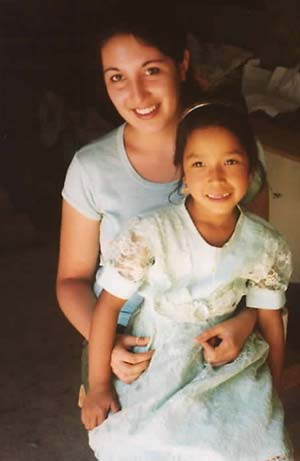|
Andrea Coronil could write a book about her experiences last summer. But she found a simple piece of paper says just as much. Coronil, an LS&A student from Ann Arbor, recalled a day she spent as a volunteer in a children’s youth center in Oaxaca, Mexico, as part of the Global Intercultural Experience for Undergraduates (GIEU). One of the women working there was feeling down, she says, and the group later found out the woman’s eldest son was missing. Coronil and another volunteer made a simple flier to post in downtown Oaxaca, where children often go to sell goods and where the woman’s son was last seen.  “She had to carry on and could not just drop everything and look for her son or call the police. She had to keep working to make sure the other kids were fed,” Coronil says. “I guess it is a pretty unusual practice to put up a flier there, but people became really curious and were asking questions and were concerned. Even a few days later, a couple of people recognized us and asked if (her son) was okay.” The boy was found later, and the ordeal contributed to Coronil’s rich experience with GIEU. She and three other U-M students and two faculty members spent several weeks in Oaxaca. They were part of a pilot group of 30 students and nine faculty who traveled to field sites around the world to experience a program designed to teach students first-hand about other cultures. Lester Monts, senior vice provost for Academic Affairs, created the program. It enables small groups of undergraduates, led by a faculty member or program leader, to learn in rich cultural environments and to gain a greater understanding of global situations and processes. At the GIEU’s first symposium Sept. 19, students and faculty recalled experiences from their summer trips. Information was available to students and faculty interested in signing up for 2003. In addition to Oaxaca, teams of students and faculty members also traveled to Senegal, Honduras, Toronto, Ghana and Detroit as part of GIEU’s inaugural class of 2002. “U-M is very much at the forefront of global education in this country, but we need to do more,” says Linda Gillum, assistant provost for academic affairs, who says the program is funded completely by the provost’s office. “We are delighted we had the success we did in the first year. We had really special students traveling with us last year and look forward to a new group joining us next year.” Faculty interested in sponsoring a trip must submit a proposal before Oct. 16. The proposal must contain several items, including project design and implementation, impact on learning, continuation and on-campus teaching. “The learning the faculty do on these trips, and their experiences, we hope will spill out into their coursework and the interactions that happen here on campus,” says A.T. Miller, coordinator of multicultural teaching and learning services for the Center for Research on Learning and Teaching. “We try and encourage programs that include this back-and-forth kind of learning.” Students must apply before Nov. 18 and will participate in a process that includes winter informational meetings, orientation, the three- to four-week field experience, a debriefing and a fall symposium. A reception is scheduled for mid-December to match small groups of students with faculty members and to begin planning for the field experiences. Miller expects GIEU to sponsor eight to 10 field sites for 2003, with 80 students participating next summer. Most of the students who traveled last summer say they learned more than they ever could in a classroom. Their experiences included learning about health care in Mexico, teaching new farming methods in Honduras, living with and studying the lives of Latino youth in Toronto, and visiting inner-city Detroit. “I feel this is really the way education should be done,” says Jacqueline Bray, an LS&A student from Ridgewood, N.J., and one of seven students who went to inner-city Detroit. “We need to read all of the books and study all of the theories, but we also need to put that into the context of a community and see the ways in which culturally, economically, socially and politically, those communities are changed by an ever-increasing global world.” One faculty-student team brought its field experience back to campus for the symposium. Faculty member Carol Richardson and Alex Chadsey, a jazz student in the School of Music, traveled to Ghana. They performed two traditional songs during the symposium, outfitted in full African dress. Richardson, associate professor in the School of Music, said none of the songs they learned from the tribe were written down, and the visitors wrote down nothing they learned from the group. They simply played music together, she says. Marcia Lee, part of the Honduras team, says she felt “privileged and blessed” after seeing the conditions of mountain farmers. Many had small houses with wooden planks bunched together, but no roof. There was little time to fix them, she says, as most of the farmers spent their days tending to crops of beans, rice and corn. “Every (field) site offers something different,” Lee, an LS&A student from Mount Pleasant, Mich., told students interested in making similar trips next summer. “Prepare yourself before you go. Think about the country and yourself before you go, and think about how (your perception) has changed after you come back.” |
September 30, 2002

